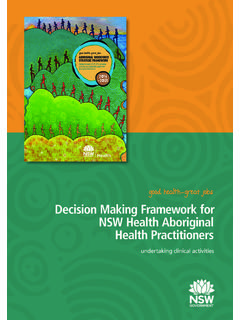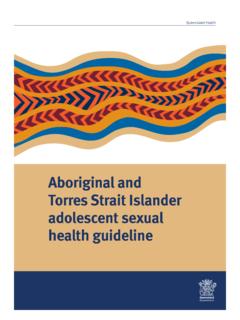Transcription of North Queensland Aboriginal and Torres Strait Islander ...
1 Queensland Health North Queensland . Aboriginal and Torres Strait Islander SEXUALLY TRANSMISSIBLE INFECTIONS. ACTION PLAN 2016 2021. An initiative of the Queensland Sexual Health Strategy North Queensland Aboriginal and Torres Strait Islander sexually transmissible infections action plan 2016 2021. Published by the State of Queensland ( Queensland Health), 2016. This document is licensed under a Creative Commons Attribution Australia licence. To view a copy of this licence, visit State of Queensland ( Queensland Health) 2016. You are free to copy, communicate and adapt the work, as long as you attribute the State of Queensland ( Queensland Health). For more information contact: Aboriginal and Torres Strait Islander Health Branch GPO Box 48, Brisbane QLD 4001. Email Phone 07 3006 2863. Disclaimer: The content presented in this publication is distributed by the Queensland Government as an information source only. The State of Queensland makes no statements, representations or warranties about the accuracy, completeness or reliability of any information contained in this publication.
2 The State of Queensland disclaims all responsibility and all liability (including without limitation for liability in negligence) for all expenses, losses, damages and costs you might incur as a result of the information being inaccurate or incomplete in any way, and for any reason reliance was placed on such information. QH723 04/16. Contents Acknowledgements 4. Goals 5. Introduction 6. North Queensland Aboriginal and Torres Strait Islander STI action plan 2016 2021 7. Implementation strengthening a regional approach 9. Promotion and prevention 12. Testing and treatment of STIs 15. Better health services 17. Monitoring and evaluation 21. Appendix 1 Epidemiological snapshot 23. Appendix 2 Staffing models 27. Appendix 3 Performance framework 33. Appendix 4 Abbreviations 37. Appendix 5 References 38. Endorsements 39. 3. Acknowledgements Queensland Health acknowledges and pays respect to Aboriginal and Torres Strait Islander people, on whose land we provide health services in Queensland , and the elders past and present.
3 This action plan has been developed in partnership between the Tropical Public Health Unit (Townsville HHS) and Tropical Public Health Services (Cairns and Hinterland HHS) and the Aboriginal and Torres Strait Islander Health Branch (Department of Health). Particular thanks to Elisha McGuiness (Tropical Public Health Unit) for drafting the plan, with clinical support from Dr Annie Preston-Thomas (Tropical Public Health Services). Consultation was wide ranging and included HHS clinical and executive staff, the Aboriginal and Torres Strait Islander Community Controlled Health Sector, Primary Health Networks and relevant academic and content experts in the field of Aboriginal and Torres Strait Islander sexual health. Specific acknowledgements to the following groups and individuals for their time and contributions: The Chairs and Boards of the five HHSs, including Mr John Bearne and Mr Col Meng, respectively the former Chairs of Townsville HHS Board and Mackay HHS Board.
4 Particular thanks to Mr Paul Woodhouse, Chair of North West HHS Board, for highlighting the importance of this issue and the need for change. Members of the Chief Executive Steering Committee for Sexual Health in Aboriginal and Torres Strait Islander people in North Queensland ', with special thanks to Dr Jill Newland, Chief Executive of Torres and Cape HHS, as Chair of this Committee. Members of the Expert Coordination Group for Indigenous Sexual Health in North Queensland , including representation from the Aboriginal and Torres Strait Islander Community Controlled Health Sector, HHS sexual health staff, the Statewide Maternity and Neonatal Clinical Network and the University of Queensland . Di Maurer, Greg Richards, Amanda Wingett and Tim Kershaw from the Department of Health's Aboriginal and Torres Strait Islander Health Branch for their ongoing support and editorial review. Staff from the Department of Health's Communicable Diseases Branch, Strategic Policy and Legislation Branch and Integrated Communications Branch.
5 Associate Professor James Ward, Head, Infectious Diseases Research Aboriginal and Torres Strait Islander Health, South Australian Health and Medical Research Institute. North Queensland Aboriginal and Torres Strait Islander 4. sexually transmissible infections action plan 2016 2021. Goals 1. Eliminate congenital syphilis in Aboriginal and Torres Strait Islander babies in North Queensland by December 2017. 2. Control the syphilis outbreaks in the North Queensland Aboriginal and Torres Strait Islander population by December 2020. 3. Progressively reduce the prevalence of syphilis, chlamydia and gonorrhoea among Aboriginal and Torres Strait Islander people in North Queensland . 5. Introduction For many years sexually transmissible infections (STIs) have been disproportionately affecting Aboriginal and Torres Strait Islander people, particularly those living in rural and remote areas. More recently, the re-emergence of infectious syphilis, with multiple outbreaks declared across four of the five North Queensland (NQ).
6 Hospital and Health Services (HHS), and the occurrences of baby deaths from congenital syphilis, have demonstrated the need for an urgent and coordinated response. Unlike many non-communicable diseases, the occurrence of STIs and their related health complications can be significantly reduced for Aboriginal and Torres Strait Islander people over a relatively short timeframe through targeted screening, treatment, contact tracing, health promotion and safe sexual practices. Snapshot for fivei HHSs in North Queensland (2010 2015). 79% (n=605) of notifications for infectious syphilis in NQ were for Aboriginal and Torres Strait Islander people. 74% of these notifications occurred in the 15 29 year old age group. Females account for 54% (n=325) of the notifications for Aboriginal and Torres Strait Islander people. Females only account for 9% (n=15) of notifications for non-Indigenous people. Six of the seven babies with congenital syphilis for this period were Aboriginal and/or Torres Strait Islander .
7 Of the seven cases of congenital syphilis, three deaths occurred, all Aboriginal and/or Torres Strait Islander For the purpose of the North Queensland Aboriginal and Torres Strait Islander sexually transmissible infections action plan 2016 2021, STIs refer to all STIs with an emphasis on infectious and congenital syphilis, chlamydia and gonorrhoea. Although the action plan has no direct focus on human immunodeficiency virus (HIV), there is convincing evidence that controlling these STIs will also reduce the risk of HIV acquisition and transmission and a potential outbreak in this at risk population1,2,3. i Torres and Cape, Cairns and Hinterland, Townsville, North West and Mackay Hospital and Health Services. ii Additional epidemiological information in Appendix 1 Epidemiological snapshot. North Queensland Aboriginal and Torres Strait Islander 6. sexually transmissible infections action plan 2016 2021. North Queensland Aboriginal and Torres Strait Islander STI action plan 2016 2021.
8 The action plan is a direct response to the increasing prevalence of syphilis in North Queensland . While aligning with the Queensland Sexual Health Strategy 2016 2021, which addresses a broad range of sexual and reproductive issues, the action plan is specifically aimed at reducing the burden of STIs in Aboriginal and Torres Strait Islander people in NQ. The action plan outlines a regional coordination approach for STI services, increasing service capacity, embedding STI testing and management in primary healthcare, and increasing prevention, testing and treatment efforts through health promotion and professional development. A coordinated regional approach ensures the best use of limited resources and draws on the strengths of each HHS to provide high quality STI services that deliver tangible and sustained outcomes. The specific activities within the action plan have been grouped into the following domains: Implementation strengthening a regional approach Implement a coordinated and planned response to ensure the reduction of STIs among Aboriginal and Torres Strait Islander people in NQ.
9 Promotion and prevention Improve the knowledge and awareness of STIs and protective behaviours among Aboriginal and Torres Strait Islander people in NQ, particularly those under 30 years of age, through the delivery of evidence based, culturally appropriate sexual health promotion. Testing and treatment of STIs Improve access to and delivery of culturally secure STI services, including best practice STI testing and management. Better health services Improve the knowledge and skills of the workforce to provide culturally secure services and appropriate models of care for delivery of STI services to Aboriginal and Torres Strait Islander people. Monitoring and evaluation Establish data collection and surveillance systems to enable the effective review of progress and improvement towards achieving the goals of the action plan. 7. hips and shared respons s ibil r tner itie Pa s Implementation . lity strengthening a Cu abi ltu regional approach l cap ral r Promotion and espe Cultura Goals Eliminate congenital syphilis prevention ct Control the syphilis outbreaks Monitoring in NQ Aboriginal and Torres and Strait Islander people Progressively reduce the evaluation prevalence of syphilis, chlamydia and gonorrhoea among Aboriginal and Torres Strait Islander people Testing Better and treatment health of STIs services Co on m p re h r o v is i ensive ser vice p Comm n u n i t y p a r ti ci p a ti o North Queensland Aboriginal and Torres Strait Islander 8.
10 Sexually transmissible infections action plan 2016 2021. Implementation . strengthening a regional approach To address STIs in a landscape of a highly mobile and young population, it is critical that the management of these infections takes a broader approach which goes beyond community, clinic service areas and HHS boundaries. Notwithstanding the need to build the capacity of existing services, a coordinated regional approach allows the identification and direction of resources to specific geographic or population groups to redress the current high rates of infectious syphilis and other STIs. As such, a clear and coordinated regional framework for management of STIs across NQ. HHS boundaries is required. Key actions in this area include having a clear mechanism for regional oversight, engagement across the five HHSs and other key partners, centralised public health support in NQ, and working with local communities and clinics. It is also important that implementation is undertaken with consideration of the following key success factors: Partnerships and shared responsibilities a coordinated approach to the reorientation of services, with clearly defined roles and responsibilities.












